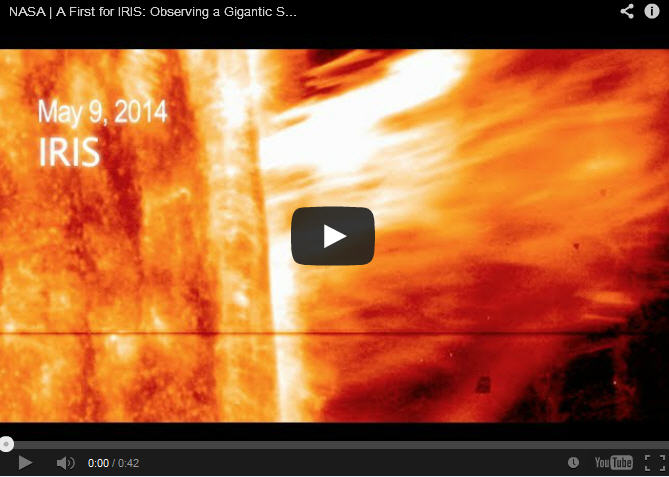A First for NASA's IRIS: Observing a Gigantic Eruption of Solar Material

A coronal mass ejection burst off the side of the sun on May 9, 2014. The giant sheet of solar material erupting was the first CME seen by NASA's Interface Region Imaging Spectrograph, or IRIS. The field of view seen here is about five Earths wide and about seven-and-a-half Earths tall. Image Credit: NASA/LMSAL/IRIS/SDO/Goddard
This was the first CME observed by the Interface Region Imaging Spectrograph, or IRIS, which launched in June 2013 to peer into the lowest levels of the sun's atmosphere with better resolution than ever before. Watch the movie to see how a curtain of solar material erupts outward at speeds of 1.5 million miles per hour.
IRIS must commit to pointing at certain areas of the sun at least a day in advance, so catching a CME in the act involves some educated guesses and a little bit of luck.
“We focus in on active regions to try to see a flare or a CME,” said Bart De Pontieu, the IRIS science lead at Lockheed Martin Solar & Astrophysics Laboratory in Palo Alto, California. “And then we wait and hope that we'll catch something. This is the first clear CME for IRIS so the team is very excited.”
The IRIS imagery focuses in on material of 30,000 kelvins at the base, or foot points, of the CME. The line moving across the middle of the movie is the entrance slit for IRIS's spectrograph, an instrument that can split light into its many wavelengths – a technique that ultimately allows scientists to measure temperature, velocity and density of the solar material behind the slit.
The field of view for this imagery is about five Earths wide and about seven-and-a-half Earths tall.
Lockheed Martin Solar & Astrophysics Laboratory designed the IRIS Observatory and manages the mission. NASA's Ames Research Center in Moffett Field, California, provides mission operations and ground data systems. NASA's Goddard Space Flight Center in Greenbelt, Maryland, manages the Explorers Program for NASA's Science Mission Directorate in Washington, D.C.
Karen C. Fox
NASA's Goddard Space Flight Center, Greenbelt, Maryland
Media Contact
All latest news from the category: Physics and Astronomy
This area deals with the fundamental laws and building blocks of nature and how they interact, the properties and the behavior of matter, and research into space and time and their structures.
innovations-report provides in-depth reports and articles on subjects such as astrophysics, laser technologies, nuclear, quantum, particle and solid-state physics, nanotechnologies, planetary research and findings (Mars, Venus) and developments related to the Hubble Telescope.
Newest articles

High-energy-density aqueous battery based on halogen multi-electron transfer
Traditional non-aqueous lithium-ion batteries have a high energy density, but their safety is compromised due to the flammable organic electrolytes they utilize. Aqueous batteries use water as the solvent for…

First-ever combined heart pump and pig kidney transplant
…gives new hope to patient with terminal illness. Surgeons at NYU Langone Health performed the first-ever combined mechanical heart pump and gene-edited pig kidney transplant surgery in a 54-year-old woman…

Biophysics: Testing how well biomarkers work
LMU researchers have developed a method to determine how reliably target proteins can be labeled using super-resolution fluorescence microscopy. Modern microscopy techniques make it possible to examine the inner workings…





















